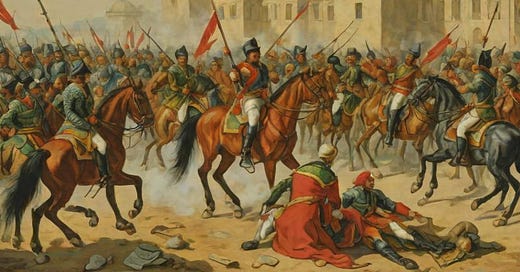Contents
Introduction
Loss of Hungary – Great Turkish War
Russo-Ottoman Wars and The Great Northern War
Ottoman-Venetian War (1714-1718) and Austro-Turkish War (1716-1718)
Ottomans Against The World
Concluding Remarks
Other News
Bitesize Edition
Today, we explore the 1700s in the Balkans and relevant surrounding regions. The Ottomans found themselves embroiled in conflicts with the Habsburgs and Russians throughout the century, as well as conflicts to the south against the Persians.
The Ottomans were debated to be in decline by this point but were certainly in stagnation. Corruption was on the rise and internal tensions rising. Both are markers of an overstretched empire without the capabilities to incite greater stability.
For the first half of the 18th century, the Ottomans were still a relatively strong force. In conflicts against the Austrians and Russians, there were often little gains made. Treaties that finalized the conflicts rarely lasted, and the same territories were fought over many times.
In the second half of the century, namely during the Russo-Turkish War of 1768-1774, the Ottoman's influence and territory began to decline with the loss of Crimea as the region known as the Crimea Khanate gained independence. In short, however, this saw Crimea fall under Russian influence. This started the expansion of Russian influence around the Black Sea at the expense of the Ottomans.
Dubbed “The Sick Man of Europe”, the Ottomans were in a difficult period. Would this difficulty last, and what came next for the Ottoman Empire?
Introduction
As we continue our journey through the history of the Balkans, today we’ll explore the beginning of the decline of the Ottoman Empire. We’ll eventually reach a point where we’ll discuss the conflict between Serbia and Kosovo, but for now, the deep history of the entire Balkan region is of vital importance in setting this conflict up.
Loss of Hungary – Great Turkish War
The Great Turkish War changed the trajectory of the Ottoman Empire. It was clear at this point in time that the Ottomans were declining in influence and power. This trend was confirmed in the 15-year Great Turkish War from 1683 to 1699.
The conflict saw the odds stacked against the Ottomans, fighting alone against the Holy Roman Empire, Poland-Lithuania, Russia, the Republic of Venice, the Spanish Empire, and the Kingdom of Hungary. The French had an informal alliance with the Ottomans in 1673 in exchange for Louis 14th being recognised as the protector of Catholics in the Ottoman territory and so weren’t involved in the fight. Yet.
Keep reading with a 7-day free trial
Subscribe to Geopolitics Explained to keep reading this post and get 7 days of free access to the full post archives.



